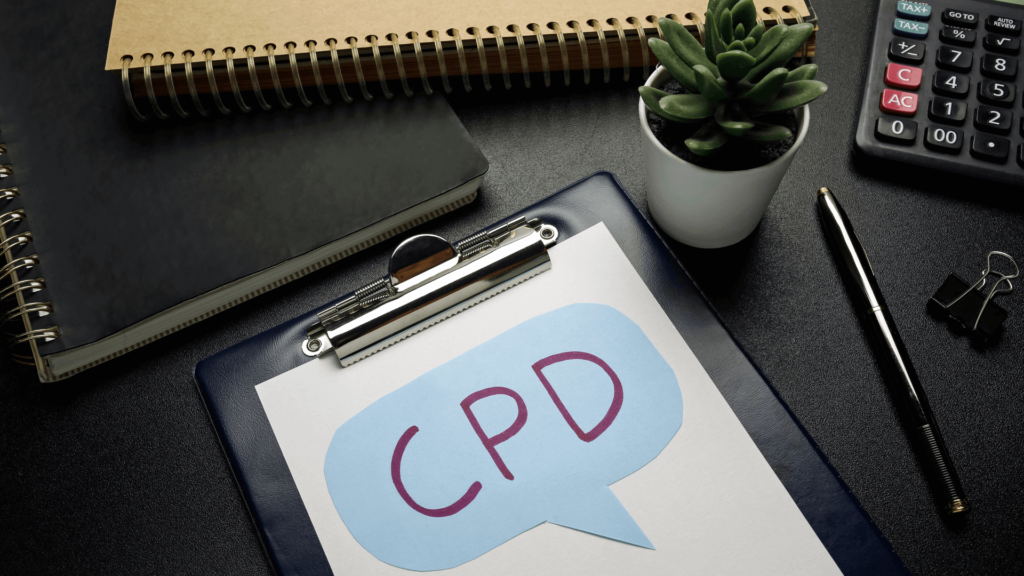Boost Your Career with CPD's: The Ultimate Guide to Continuing Professional Development

What is Continuing Professional Development (CPD)?
Continuing Professional Development is a key component of maintaining a successful career in today's competitive job market. It encompasses both formal and informal learning activities, such as attending workshops, seminars, and conferences, as well as engaging in self-directed learning and reflection.
By actively participating in CPD, professionals can stay abreast of industry trends, expand their expertise, and remain competitive in the job arena.
The advantages of CPD are numerous. It provides individuals with the opportunity to remain current on knowledge and skills, allowing them to remain relevant in a swiftly changing job market.
CPD also facilitates personal growth and development, enabling individuals to take on greater responsibilities and challenges. Furthermore, it can foster confidence and increase job satisfaction by providing a sense of accomplishment and progress.
Ultimately, CPD encourages professionals to continuously improve and stay ahead in their respective fields.
Engaging in CPD requires a proactive approach and an attitude of lifelong learning. Professionals should set clear goals identify areas for improvement, and then explore various CPD activities that align with their personal and professional objectives.
Activities may include attending training programs, reading industry publications, or receiving an online education. With the right commitment, professionals can empower themselves to enhance their skills, broaden their knowledge base, and position themselves for success in the job market.
Benefits of CPD
One of the key advantages of engaging in continuous learning and development is the ability to foster your professional growth. By taking part in ongoing training and education, you can broaden your knowledge base and hone your abilities to remain current and competitive in your field.
This offers a platform for you to explore fresh ideas, techniques, and technologies that can have a positive effect on your work.
It allows you to stay abreast of the latest industry trends, giving you the resources to excel in your role. Moreover, CPD can open the door to new career prospects, as employers often value those who demonstrate a commitment to ongoing professional development. By taking the time to invest in your CPD, you are investing in yourself and your long-term success.
A further significant benefit of engaging in continuing professional development is the potential for personal and career advancement. Through CPD activities, you can acquire new skills and information that not only contribute to your professional advancement but also increase your self-confidence and self-esteem.
By consistently developing yourself, you become more agile and robust, able to navigate and thrive in an ever-evolving work landscape.
CPD also provides the opportunity for networking and collaboration with like-minded professionals, granting you the chance to expand your professional network and gain valuable insights and perspectives.
Furthermore, CPD can enhance your job satisfaction, as it allows you to take on new challenges and responsibilities, leading to a sense of achievement and accomplishment in your work. In summary, the advantages of CPD are numerous and far-reaching, offering you the opportunity to uncover what you can achieve both personally and professionally.
How to Start Your CPD Journey
In your quest for professional growth and development, your initial step must be to begin your CPD journey. This process enables you to refine your abilities, expand your knowledge, and remain up-to-date in your field. To get started, it is critical to conduct a self-evaluation to recognize your current strengths and weaknesses.
By assessing yourself, you can pinpoint areas of excellence and those that require improvement. This reflective process will form the basis for choosing the most suitable CPD activities to pursue.
Bear in mind, that the secret to success in your CPD journey lies in understanding your starting point and setting clear goals to drive your progress.
Once you have identified your areas of focus, it is time to investigate the various CPD activities available. These activities can span from attending seminars and conferences to engaging in virtual courses or participating in professional networks. The key is to select activities that sync with your particular skill-development requirements and interests.
Also, ponder seeking advice from mentors or industry pioneers who can provide valuable guidance and suggestions.
By diversifying your CPD activities and embracing different learning approaches, you can maximize your growth potential and acquire a well-rounded skill set.
Although it is imperative to actively participate in CPD activities, it is equally vital to track your advancement and contemplate your learning voyage. Keeping a record of the CPD activities you complete will not only assist you in monitoring your development but also serve as proof of your commitment to professional growth.
Think about creating a CPD portfolio where you document your accomplishments, reflections, and any additional resources or materials that contribute to your learning.
By periodically examining your CPD records, you can measure your growth, pinpoint areas for further enhancement, and make judicious decisions about upcoming CPD endeavors. Remember, in the realm of CPD, self-awareness, and ongoing assessment are the keys to unlocking your true potential.
Examples of CPD Activities
Enhancing your professional growth and remaining up to date with industry trends can be accomplished through several activities. Attending conferences and seminars provides a great opportunity to learn from specialists in your area and establish connections with other professionals.
Webinars and online courses are an excellent way to access resources from the comfort of your own home.
Joining professional associations and organizations can also provide access to workshops and training sessions that aim to help you build new abilities and expand your knowledge.
Self-directed learning is another beneficial activity for professional development. This can involve staying informed of the newest developments and research by reading industry publications, research papers, and books. Participating in online discussion forums and conversations with other professionals in your field can also lead to exchanging ideas and insights.
Hands-on experience and practical application of knowledge are equally important. This can include taking on projects and assignments that push you to broaden your skills and understanding. Seeking out mentorship opportunities can provide valuable guidance and direction from experienced professionals.
Volunteering your time and expertise in your community or within your professional organization can not only contribute to your growth but also give back to your industry.
Last but not least, reflective practice is a critical exercise that involves reflecting and analyzing your own professional experiences and taking away learnings from them. This can include regularly reviewing and reflecting on your successes, struggles, and areas for improvement.
Keeping a reflective journal or portfolio can help track progress and identifying areas where you can further develop. Obtaining feedback from peers or formal assessments can also offer valuable insights and help you identify areas for growth, thereby helping you build a successful career.
The Cambridge English Teaching Framework
The Cambridge English Teaching Framework is an essential component of professional development for teachers, providing comprehensive guidance and support to cultivate teaching skills. This framework affords a structured approach to refining your learning and ensuring your professional growth.
By following the instructions set out in the Cambridge English Teaching Framework, teachers can continuously elevate their teaching approaches and remain up-to-date with the latest educational practices.
No matter if you are a novice teacher or a seasoned educator, the Cambridge English Teaching Framework is an irreplaceable resource for advancing your teaching career.
The framework presents a defined roadmap for teachers to develop their teaching aptitudes and understanding. It supplies a variety of systems and techniques that can be applied in the classroom to advance student learning and involvement.
With the Cambridge English Teaching Framework, you can pinpoint areas for improvement and set objectives to refine your teaching procedure. By recurrently reflecting on your teaching methods and implementing fresh approaches, you can guarantee that your students are receiving the best possible education.
The framework also promotes collaboration and professional networking, allowing teachers to learn from their peers and exchange ideal practices.
A key aspect of the Cambridge English Teaching Framework is its emphasis on your learning. It underscores the importance of continual professional development and encourages teachers to search for occasions for growth.
By participating in professional growth activities such as workshops, conferences, and online courses, teachers can broaden their knowledge and remain abreast of the latest advancements in the field of education.
The framework also urges teachers to contemplate their teaching practice and seek out feedback from colleagues and students. By deliberately searching for opportunities for improvement, teachers can amplify their abilities and become more efficient educators.
Overall, the Cambridge English Teaching Framework is a priceless tool for teachers looking to boost their professional growth. By following the guidelines and strategies detailed in the framework, teachers can continuously strengthen their teaching methods and stay current with the latest educational practices.
Whether you are a new teacher or an experienced educator, the framework offers a comprehensive approach to professional development that will benefit both you and your students.
Embrace the opportunities for growth provided by the Cambridge English Teaching Framework and take your teaching practice to new heights.
CPD Strategies for Professional Development
To maximize your career growth, it is imperative to embrace effective strategies for continuing professional development. Begin by taking stock of your abilities and setting concrete objectives. Afterward, locate and utilize learning chances that are pertinent to your professional targets.
This could mean taking part in seminars, webinars, or online courses.
Additionally, don't forget the value of networking and collaboration. Connect with other industry professionals, partake in forums, and consider mentoring opportunities to further enhance your knowledge and skill set.
Self-reflection is a key component of any successful professional development plan. Through self-assessment tools or feedback from colleagues and mentors, you can identify areas for improvement and customize your activities accordingly. By actively engaging in these learning opportunities, you can stay abreast of the latest industry trends and acquire new skills.
Furthermore, networking and collaboration can open up valuable resources and expertise which can contribute to your growth.
Collaborating with peers on projects and sharing knowledge through mentoring programs is a great way to expand your professional network and gain insight. Seek out opportunities to join professional associations, participate in industry events, or engage in online communities.
By taking an active approach to connecting with other professionals in your field, you can reap the rewards of a more comprehensive and impactful professional development experience.
How to Record Your CPD
To get the most out of your Continuing Professional Development, it's important to understand the process of recording and tracking your activities. A reliable system allows you to monitor your progress, pinpoint areas of growth, and showcase your commitment to professional growth.
To begin this process, create a structured recording system that works for you. This could be in the form of an online portfolio, a CPD tracking tool, or a physical folder or journal.
Whichever approach you choose, make sure to include pertinent info such as the date, activity description, learning outcomes, and reflections on how it has contributed to your professional journey.
In addition to documenting your activities, it's essential to collect evidence of your CPD. This could be in the shape of certificates, training materials, presentations, reports, or any other tangible proof of your participation and learning.
Gathering feedback and evaluations from colleagues, mentors, or trainers can also be beneficial in providing insights into the impact of your CPD activities.
Recording your CPD allows you to go beyond simply noting down your activities. It offers a platform to reflect on your learning and development. Take the time to assess the effectiveness of each activity and contemplate how it has impacted your professional practice.
Think about the new knowledge and skills you have acquired, as well as the challenges you have overcome. This reflective process will help you to deepen your understanding and better apply what you have learned in your role.
It's also essential to review and analyze your CPD records regularly. This can allow you to identify patterns, trends, and areas for improvement. Search for opportunities to diversify your learning experiences and explore new areas of interest. Seek feedback from peers and mentors to get a better perspective on your professional development.
By engaging with your CPD records and applying them as a guide, you can keep refining your growth and reap maximum benefit from your activities.
BCS Volunteer Roles for CPD
Engaging in volunteer work provides a unique and rewarding way to further your professional development journey. Not only can it allow you to give back to your community or workplace, but it also offers the opportunity to expand your network and hone your skillset.
Taking on a BCS volunteer role is a great way to make a meaningful difference while also enhancing your career growth.
Whether you choose to mentor, share your expertise through workshops or presentations, or contribute to BCS initiatives, these roles provide a platform for you to reach your professional aspirations.
When selecting a BCS volunteer role, it is important to find one that resonates with your interests and ambitions. BCS offers a variety of opportunities to get involved, from committee membership to event coordination and more.
By taking on a role that aligns with your goals, you can maximize the impact of your involvement while gaining valuable experience and insight. Whether you are looking to develop your leadership abilities, sharpen your project management skills, or expand your network, there is a volunteer role that is perfect for you.
Volunteering with BCS not only provides the chance to contribute to the profession but also opens doors for personal growth and advancement. Participating in these roles allows you to showcase your commitment to professional development and demonstrate your dedication to continuous improvement.
Additionally, volunteering can boost your professional reputation and credibility, as it highlights your willingness to go above and beyond in your field. Investing your time and expertise in a meaningful way, through BCS volunteer roles, is a great way to make a difference, broaden your horizons, and propel your career forward.
Leave a Reply




Related Posts